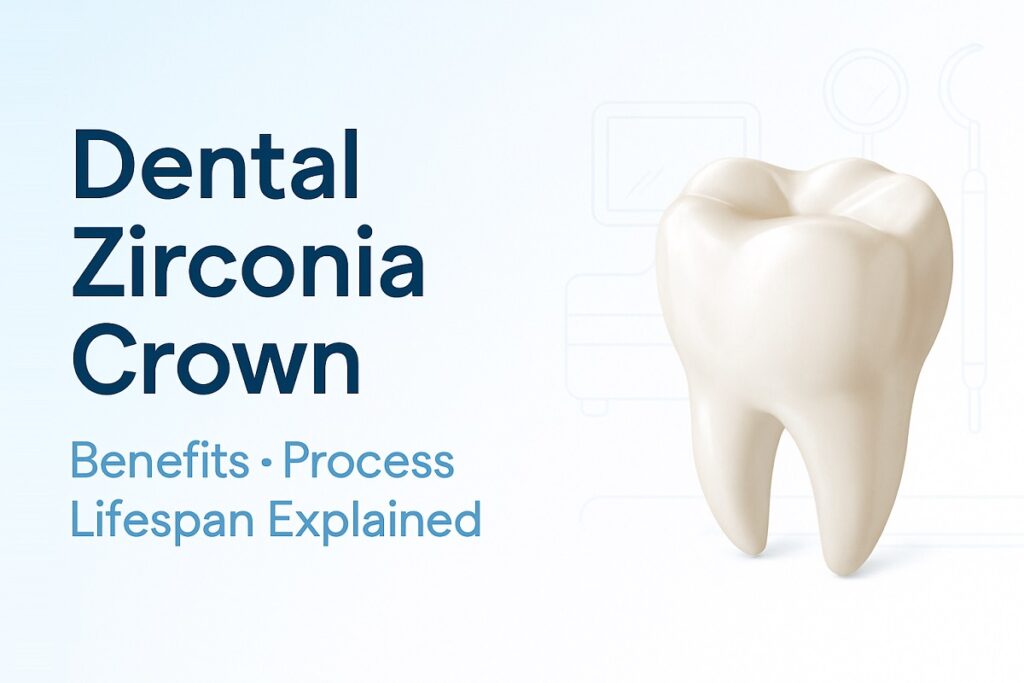If you or someone you know is considering a dental crown, you may have encountered the term zirconia crown. In simple terms, a zirconia crown is a type of dental restoration made from zirconium dioxide (ZrO₂) that’s used to cover or cap a damaged tooth. This article will guide you through what a zirconia crown is, how it’s made, when it’s used, its pros & cons, and how to care for it — all in a straightforward, general information style (not a promotion).
What is a zirconia crown?
A dental crown is essentially a “cap” fitted over a tooth that has been damaged, worn, or undergone root canal treatment, to restore its shape, size, strength, and appearance. A zirconia crown uses zirconium dioxide — a high-strength ceramic material — instead of older materials such as metal alloys or porcelain fused to metal. Key points:
- Zirconia (ZrO₂) is a crystalline oxide of the metal zirconium; it’s chemically inert and very strong.
- Crowns made of zirconia can be monolithic (one solid block) or layered to improve aesthetics.
- Often, these crowns are fabricated using CAD/CAM (computer-aided design/manufacturing) methods, which allow high precision.
Why are they used (Indications)?
There are multiple reasons why a dentist might recommend a zirconia crown. Some of the common indications include:
- A tooth that is severely decayed or has a very large filling needs strength and full coverage.
- A tooth that’s been treated with a root canal is thus structurally weaker.
- A tooth that’s worn down by grinding or heavy bite forces, where durability is important.
- For patients who prefer a metal-free restoration (for reasons of allergy or aesthetics).
- For aesthetic restorations, especially when layering and translucency of zirconia are used (front teeth).
In short, if you need a strong, long-lasting crown and want good aesthetics with minimal metal, a zirconia crown is often a very suitable choice.
How are zirconia crowns made and fitted?
Here’s a simplified step-by-step look at how these crowns are typically created and placed.
- Initial consultation & preparation
The dentist examines the tooth, takes X-rays if needed, assesses whether a crown is appropriate, and determines how much of the natural tooth must be removed (to make space for the crown). - Tooth reduction/shaping
The tooth is prepared by reducing its size — for zirconia crowns, the tooth reduction can sometimes be less than older materials. - Impression / digital scan
Either a physical impression of the prepared tooth is taken, or a digital intra-oral scan is done. The data is used to design the crown. - Design & milling/fabrication
Using CAD/CAM, a zirconia block is milled into the crown shape. If required, layering or staining can be done to match the color of adjacent teeth. The zirconia is then sintered (baked at high temperature) to reach full strength. - Try-in and cementation
The dentist fits the crown in the patient’s mouth, checks the fit, bite, and color match, and then permanently cements it in place. Once cemented, the crown functions like a natural tooth.
Because zirconia can be fabricated relatively quickly in some clinics with in-house CAD/CAM systems, same-day crowns are possible in some cases.
Advantages of zirconia crowns
Several benefits have made zirconia crowns increasingly common in modern dentistry:
- High strength and durability: Zirconia crowns have excellent fracture resistance and can tolerate heavy chewing forces, making them suitable even for back (molar) teeth.
- Metal-free / biocompatibility: Because they are free of metal, they are suitable for patients with metal allergies or sensitivities; they also avoid the dark “line” at the gum that some metal-based crowns have.
- Good aesthetics: Especially newer high-translucency zirconia and layered types allow better color match and a more natural appearance.
- Precision fit: CAD/CAM production allows a very accurate fit, reducing gaps and chances of cement failure or bacterial ingress.
- Less tooth removal: Some zirconia crowns require less reduction of natural tooth structure compared to older crown types.
- Stain resistance and minimal corrosion: The surface of zirconia is non-porous and doesn’t stain easily; it doesn’t corrode like some metal alloys.
Potential disadvantages and considerations
While zirconia crowns offer many benefits, they also come with certain trade-offs and things to keep in mind:
- Cost: Zirconia crowns tend to cost more than basic metal crowns or porcelain-fused metal options.
- Aesthetics in some cases: Solid monolithic zirconia (which is very strong) can be less translucent than natural enamel or some porcelain crowns, so in highly visible front teeth, one might find it slightly less lifelike unless layering/translucent types are used.
- Wear on opposing teeth: Because zirconia is very hard, it’s theoretically possible that it might wear down the natural opposing tooth if the opposing surface is unprotected and the fit/polish is not ideal.
- Technique sensitivity: The success of the crown depends on accurate fit, proper cementation, and correct tooth preparation. Poor fit or inadequate margin may lead to failure, just like any crown.
- Limited long-term data: Though the material has been in use and shows good performance, unlike older materials, there’s less decades-long data.
Typical lifespan & maintenance
What can someone expect in terms of longevity and care?
- Many dentists estimate that a well-fitted zirconia crown can last 10 years or more, and in many cases, much longer.
- The actual lifespan depends heavily on:
- Oral hygiene (brushing, flossing)
- Bite habits (grinding/clenching can stress crowns)
- Quality of the crown fit and margin integrity
- Opposing teeth condition and how well the crown was polished and finished
- Maintenance is similar to natural teeth: regular cleanings, avoiding chewing very hard objects (ice, very hard candy), and maintaining overall gum health.
How to decide if zirconia is right for you
Here are some questions you might consider (and discuss with your dentist) when evaluating a zirconia crown:
- Is this crown being placed in a high-stress area (molars/back teeth)? If yes, then strength is a priority — zirconia is a strong choice.
- Is the crown in a visible part of the smile (front teeth)? Then aesthetics become more important — ask about translucency, layering, and color match of the zirconia crown.
- Do you have any metal allergies or sensitivities? If yes, a metal-free crown like zirconia may benefit you.
- What is the condition of the opposing tooth? Will a very hard crown risk wearing the other tooth?
- What is the cost difference compared to other crown materials, and does your dental insurance cover it (or add an upgrade cost)?
- How much of your natural tooth will need to be reduced/prepared for this crown? Will zirconia allow less removal?
- What lab or technology is the dentist using for fabrication (CAD/CAM in-house or outsourcing)? Quality of fit matters.
Summary: What to keep in mind
- A zirconia crown is a high-strength, metal-free ceramic crown made from zirconium dioxide; it’s increasingly used in modern dentistry.
- It offers durability, biocompatibility (less chance of allergy), good aesthetics (especially with newer types), and can be milled precisely using CAD/CAM.
- However, the cost is higher than some older crown types, aesthetics may vary depending on the specific type of zirconia and technique, and one must ensure a good fit/finish to avoid issues.
- Good oral hygiene and proper care will maximize the lifespan of the crown.
- Always consult with your dentist about your specific tooth situation (location, bite forces, aesthetic requirements) and ask about the type of zirconia, lab work, warranty/expectations, and any alternatives.
Final thoughts
In essence, if you are looking for a crown restoration and want a modern, durable, metal-free option, a zirconia crown is a very strong candidate. But as with any dental treatment, it works best when the choice is matched to your individual needs—whether it’s strength, appearance, cost, or long-term performance. Discuss openly with your dentist, ask questions, and decide together what fits you best.

